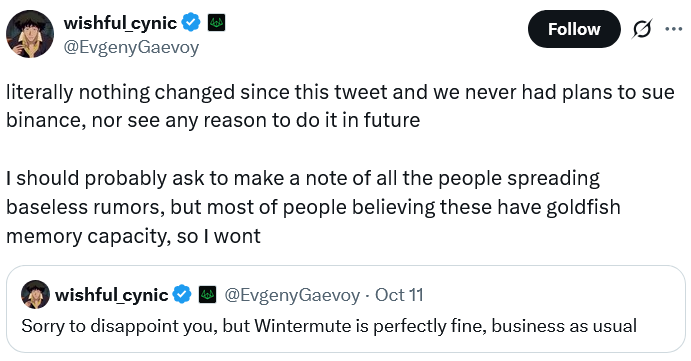Wintermute CEO Evgeny Gaevoy has firmly denied rumors of suing Binance over losses from the October 10, 2025, Bitcoin flash crash, where prices dropped 15.2% to below $103,000 amid $20 billion in liquidated positions. No such plans exist, and the claims stem from unverified social media posts.
-
Wintermute provides liquidity on Binance, aiding market stability during volatile events like the flash crash.
-
Gaevoy labeled the lawsuit rumors as baseless, urging reliance on official sources to combat misinformation.
-
The crypto market dipped 3% to $3.65 trillion on Monday, influenced by liquidations totaling $1.3 billion and persistent whale selling above $100,000 Bitcoin levels.
Wintermute Binance lawsuit rumors debunked: CEO denies plans to sue over October flash crash losses. Explore facts on market stability and crypto volatility. Stay informed on Bitcoin trends. (148 characters)
What are the Wintermute Binance lawsuit rumors?
Wintermute Binance lawsuit rumors emerged following the dramatic Bitcoin flash crash on October 10, 2025, when the cryptocurrency plummeted 15.2% from $121,560 to below $103,000, triggered by U.S. President Donald Trump’s tariff announcement. These rumors suggested that Wintermute, a prominent market-making firm providing liquidity on Binance’s platform, intended to pursue legal action against the exchange for alleged failures in its auto-deleveraging mechanism, which reportedly led to significant unconfirmed losses for the firm. However, Wintermute’s CEO, Evgeny Gaevoy, swiftly refuted these claims in a public statement on X, emphasizing that no such lawsuit was planned and dismissing the speculation as unfounded.

Source: Evgeny Gaevoy
Wintermute plays a crucial role in the cryptocurrency ecosystem as an independent trading firm. By offering liquidity on platforms like Binance, it helps maintain price stability and enhances overall market efficiency, particularly during periods of high volatility. The flash crash in question wiped out approximately $20 billion in leveraged positions across the broader market, underscoring the interconnected risks in centralized exchanges.
The rumors gained traction through social media, with an X user known as WhalePump Reborn alleging that Wintermute was seeking reimbursement for losses tied to Binance’s risk management shortcomings. This post claimed Binance disputed the compensation amounts, but Gaevoy directly addressed it, calling the narrative a “complete bullshit” and a fabrication. He further noted that while he could document those spreading the misinformation, most believers would quickly forget, highlighting the transient nature of online FUD (fear, uncertainty, and doubt).
How did the October 10 Bitcoin flash crash impact market makers like Wintermute?
The October 10, 2025, flash crash had profound effects on market makers such as Wintermute, whose liquidity provision was tested amid the rapid price decline. Bitcoin’s drop from $121,560 to under $103,000 occurred in the wake of geopolitical news, amplifying leverage-related vulnerabilities. According to industry data, the event led to over $20 billion in liquidated positions, with market makers facing potential imbalances due to the exchange’s auto-deleveraging failures.
Wintermute, known for its algorithmic trading strategies, transferred more than $700 million to a Binance hot wallet shortly before the crash, which fueled additional speculation about its involvement. However, experts in cryptocurrency risk management, including those from regulatory bodies like the U.S. Commodity Futures Trading Commission (CFTC), have long emphasized that such transfers are routine for liquidity purposes and do not imply causation in price movements. Gaevoy’s rebuttal aligns with this view, reinforcing that no legal recourse was being considered.
Supporting statistics from on-chain analytics firms, such as Chainalysis, indicate that flash crashes of this magnitude often result from a combination of high leverage ratios—averaging 10x or more on platforms like Binance—and external triggers. In this case, the tariff announcement exacerbated selling pressure from Bitcoin original gangsters (OGs), or long-term holders, who continued offloading assets even as prices hovered above $100,000. This dynamic not only pressured market makers but also contributed to broader market jitters, with retail investors retreating to safer levels around $98,500 in the ensuing days.

Source: Changpeng Zhao
Furthermore, the incident spotlighted the importance of robust risk controls. Binance’s former CEO, Changpeng Zhao, advised his 10.4 million X followers to verify information through official channels, a stance echoed by financial watchdogs. Crypto influencers amplified the initial FUD, but official denials from Wintermute helped mitigate panic, demonstrating the firm’s commitment to transparency in a sector prone to misinformation.
Frequently Asked Questions
Is Wintermute actually planning to sue Binance over the flash crash?
No, Wintermute has no intention of suing Binance regarding the October 10, 2025, flash crash. CEO Evgeny Gaevoy explicitly stated on X that such rumors are baseless and no future plans exist for legal action, countering claims of losses from auto-deleveraging issues. (47 words)
What caused the Bitcoin price drop on October 10, 2025?
The Bitcoin flash crash on October 10, 2025, was primarily triggered by U.S. President Donald Trump’s tariff announcement, leading to a swift 15.2% decline from $121,560 to below $103,000. This event, combined with high leverage and whale selling, resulted in $20 billion in liquidations, impacting the entire crypto market’s stability. (52 words)
Key Takeaways
- Misinformation spreads quickly in crypto: Rumors like the Wintermute Binance lawsuit claims highlight the need for verifying facts from official sources to avoid unnecessary market volatility.
- Liquidity providers are essential: Firms such as Wintermute stabilize exchanges during crashes, but external events like policy announcements can overwhelm even advanced risk mechanisms.
- Market recovery patterns: Despite a 3% dip to $3.65 trillion, Bitcoin remains above $100,000, signaling resilience—investors should monitor whale activity and leverage trends for informed decisions.
Conclusion
In summary, the Wintermute Binance lawsuit rumors have been thoroughly debunked by CEO Evgeny Gaevoy, clarifying that no legal action stems from the October 10, 2025, flash crash that saw Bitcoin fall amid geopolitical tensions. This event, while causing $20 billion in losses and a subsequent 3% market decline to $3.65 trillion, underscores the crypto sector’s volatility and the critical role of liquidity providers like Wintermute in maintaining efficiency. As Bitcoin prices stabilize above $100,000 despite ongoing whale sales, market participants are encouraged to prioritize official communications and diversify strategies to navigate future uncertainties effectively.
The crypto market’s resilience is evident, with analysts forecasting continued growth in 2025 as regulatory clarity improves. Staying informed through reliable channels will be key to capitalizing on emerging opportunities in this dynamic space.





